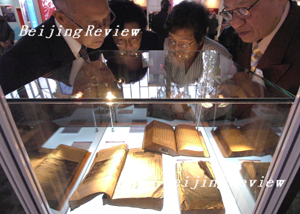| 
Worldwide translation of the Bible began in the 3rd century B.C., but records of the Chinese version of the Bible go back to around the 7th-8th century.
According to Gu Changsheng, a researcher of the history of Christianity in China, the earliest translation of the Bible in China can be found at the time of the Tang Dynasty (618-907). In 635, foreign churchmen arrived in Xi'an, capital of the Tang Dynasty, preaching and translating the Bible. Some incompletely translated versions of the Bible were published and circulated, but were lost over time.
During the Yuan Dynasty (1271-1368), missionaries from Western Europe came to China and translated all the New Testament and Psalms into Chinese. It's said that the translated version was transcribed with fine Chinese calligraphy. Unfortunately, no copies still exist today.
From the last years of the Ming Dynasty (1368-1644) to the early years of the Qing Dynasty (1644-1911), West European Catholic missionaries returned to China again. During the 130-year period of their preaching, the Chinese version of the Bible hadn't yet been published. The only information available was question and answer lists for Chinese disciples to read, which contained some quotes from the Bible.
In the early years of the 18th century, French Catholic missionaries translated some parts of the Bible into Chinese. The translated manuscript is now kept in the Museum of London.
It was only in the early years of the 19th century that Protestant missionaries started translating the whole Bible into Chinese. The earliest Chinese version of the Bible appeared in 1822.
The first Protestant missionary who came to China was an Englishman called Robert Morrison, who arrived in the southern city of Guangzhou in 1807. Some experts say that he was also the earliest Christian to run a school in China. In 1814, he published the New Testament he had translated independently. In 1823, he worked in cooperation with another Protestant missionary, William Milan, to publish a whole translated version of the Bible, bound with traditional thread and containing 21 volumes. It is referred to as "Morrison's Version." From that time the complete version of the Bible was introduced to China.
When Protestant missionaries in China held a representative meeting in Hong Kong in August 1843, they passed a resolution on re-translating the previous Chinese versions of the Bible. During the re-translation, missionaries engaged in the translation were at odds on translating some terms. Their biggest point of contention was whether to translate God into shen or shangdi. Agreement was never reached and the two translating teams each translated it in their own way.
The team that translated God into shangdi published the New Testament in 1852 and the Old Testament in 1854. The other team published the complete translated shen version of the Bible in 1863.
In 1868, the translation work led by Baptist J. Goddard was completed, and the translated Bible, called "Goddard's Version," was published.
In 1890, Protestant missionaries in China held a nationwide meeting in Shanghai and passed a resolution that all sects of the Protestant community unite to form a translation team. After working on the project for 28 years, the new Chinese version of the Bible was published in 1919, with the vernacular Chinese version proving especially popular. After more than 80 years, this version is still widely used in China, but is divided into the shen version and the shangdi version.
In addition, some missionaries had dedicated themselves to translating the Bible into various Chinese dialects. For example, there are two versions in the Shanghai dialect. One is in Chinese and the other is in Pinyin (the phonetic system for transcribing Chinese characters). From the 1860s to the early years of the 20th century, translated versions of the Bible in more than 30 ethnic minority languages in China were published, most of which were in the Latin alphabet pinyin developed by foreign missionaries.
However, foreign Christians have said publicly that translation of the Bible by foreign missionaries should be confined to history, and they hoped Chinese Christians could take on the important task of translating the Bible themselves and publishing a Chinese version faithful to the original text and catering to the majority of Christians in China.
After 60 years, the modern Chinese version of the Bible co-translated by Chinese Christian scholars was published in Hong Kong, translated by Xu Mushi, Luo Weiren, Zhou Lianhua, Wang Chengzhang and Jiao Ming. What is disappointing is that this version hasn't been widely circulated until now.
In some experts' opinion, translating the Bible into Chinese has high requirements: First, the translators must be devout Christians; second, they should undergo rigorous learning of Chinese and foreign languages such as ancient Hebrew, ancient Greek, German and English; third, they should be familiar with lection and church history; and finally, they should steer clear of ideology and prejudice, translate in pure Mandarin Chinese, and seek unity of the translation of "God," avoiding the influence of different factions. It is also felt that young Christians should be trained for this purpose and funds raised from local Christians in order to set up a Chinese Bible translation fund.
Translation and publication of the Bible in China has a long history, and although not all the past versions are now locally available, some rare editions have survived in the American Bible Society Library in New York, the Museum of London and Hong Kong.
"I was lucky to have seen some editions in Shanghai. During my study in the United States, I once went to the American Bible Society Library and saw most of the rare editions. I spent about three months in the library in researching to write a paper," said Gu Changsheng, whose works include Missionaries and Modern China and Brief History of Christians in China. | 